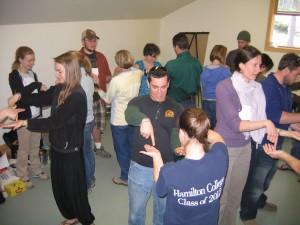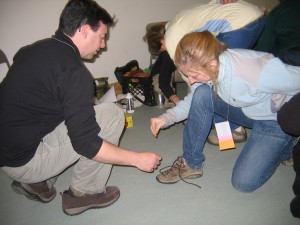
Sep 16, 2010 Get Them Moving, Keep Them Engaged
 If you are reading this post, chances are you believe it is important to find ways to actively engage learners in your classroom, boardroom, or group counseling setting. However, when we have a lot of material to cover in our lesson plans or agendas some of us might find ourselves forgetting just how important regular movement and social interaction is for increasing attention and learning outcomes.
If you are reading this post, chances are you believe it is important to find ways to actively engage learners in your classroom, boardroom, or group counseling setting. However, when we have a lot of material to cover in our lesson plans or agendas some of us might find ourselves forgetting just how important regular movement and social interaction is for increasing attention and learning outcomes.
Studies on attention demonstrate that though attention varies from person to person and can be affected by time of day and other factors, there are fewer lapses of attention during lecture and direct instruction situations when active learning methods are used, and when reflective questions are posed (Bunce, Flens & Neiles, 2010).
Neuroscientists are recommending that educators find ways to “break up” lectures and direct instruction with intentional opportunities to engage learners in dialogue, reflection, and movement. Mixing up our methods for delivering and reviewing lessons helps learners create more neuro-pathways for the information to be stored and accessed later. (See my Summer Reading List post from July 28th for some great resources regarding research on the brain and learning).
Getting participants away from their desks and moving can enhance a lecture or presentation by providing an opportunity for learners to interact with each other and reflect upon the information being presented. Brain researchers are showing that if learners reflect on a lesson in an active or social way they will likely retain it longer and integrate it better into their life and future learning.
In previous posts I shared some of my favorite ways to engage learners in community building, dialogue and reflection (see the January, March, and April 2010 posts). These same activities could be used after 15-20 minutes of lecture to get student or group participants away from their seats, moving and reflecting on the material just presented.
One of my favorite and “tried and true“ methods for actively engaging a group in dialogue and reflection about a lesson or experience is Concentric Circles. This activity works especially well for large groups.
- In this activity the group is divided in half, and two circles are formed, with the participants facing each other in an inner circle and an outer circle.
- The participants are asked to greet each other and then converse about the topic at hand. You could have very specific questions about the material prepared for partners to discuss. Or initiate a less structured conversation inviting participants to share their reactions to, or key takeaways gleaned from a lecture, or in the case of a team-building session, the group’s experience.
- When discussing current events, or a hot topic for an organization you might have the inside circle represent one point of view and the outside circle another.
- Depending on the group, I sometimes incorporate a fun partner activity such as “finger fencing” or “gotcha” or “one handed shoe tying” prior to the reflection or review discussion. This brings a little fun into the classroom or boardroom and helps participants create social connections (another brain-friendly method of teaching).
- After completing the partner activity, participants are asked to share their thoughts about the lecture, lesson or reading. One teacher I shared this activity with uses it in her language arts class. She had the inside circle take the perspective of one character in a play and the outside circle another, and then asked them to answer questions “in character”.
- After a few moments, or when the conversational energy diminishes, the teacher or group facilitator invites the inner circle to rotate and form new partnerships by having the inner group move three spaces to the left, saying hello to those two they pass by. These new partners greet each other; the facilitator provides another cooperative activity and/or question to discuss.
- The activity continues with alternating movement between the inside and outside circle, followed by questions (and partner activities if appropriate).
- I sometimes pair “themed” questions with some of the partner activities. For example, in some teacher staff development workshops after I engage the partners in “ collaborative one-handed shoe tying” (a partnered task) I ask teachers to share their experiences with co-teaching.
A benefit of this type of review is that learners who tend not to share their reactions or questions about a lecture in a large classroom setting will have an opportunity to share in a less intimidating one on one dialogue. The randomness of the pairing is an additional “classroom community building” benefit as participants might be paired with students outside of their usual social group.
Last spring while working with a group of corporate trainers I suggested using this as an active reflection method in their team-building work and presentations with business executives. One participant commented “if I use Concentric Circles to reflect on a lesson I won’t be able to hear what my participants are saying about the activity or lesson.” Our group discussed although this is true, a benefit of this method is helping our participants engage dialogue more readily and more deeply when they are not being put on the spot in front of the group. In the long run it will allow your group to become more open and willing to share later on in the group process because they are building comfort with sharing by starting with one person at a time.
Since that conversation I continue to reflect on this topic. I notice in my recent work both in the classroom and in team-building sessions if something was shared during a partner dialogue that is important for the whole group or facilitator to hear, it will come up again later in the group process.
If the partners are discussing review questions and reactions to a classroom lecture, at the end of the activity you could ask volunteers to share key ideas that came up in their conversations.
Whether you are a classroom teacher, college professor, corporate trainer or counselor you will find that incorporating movement into your presentations and discussions will increase participant engagement and help learners better retain and synthesize information from your lessons.
Activity Reference: I first learned this activity from Paul Hutchinson during our time as grad students at MSU Mankato. It is also written up in: A Teachable Moment, Cain, Cummings, and Stanchfield, 2005. Kendall Hunt Publishing and Tips & Tools for the Art of Experiential Group Facilitation.
References:
Radteach.com (information on the brain, attention and learning)
Bunce, D. M., Flens, E A., & Neiles, K. Y. (2010). How long can students pay attention in class? A study of student attention decline using clickers. Journal of Chemical Education, 87, 1438-1443.
Cain, J., Cummings, M., & Stanchfield J. (2005). A Teachable Moment: A Facilitator’s Guide to Activities for Processing, Debriefing, Reviewing and Reflection
Stanchfield, Jennifer. (2007) Tips & Tools: The Art of Experiential Group Facilitation.
Willis, Judy (2006) Research-Based Strategies to Ignite Student Learning




Kelly Boucher
Posted at 06:39h, 17 SeptemberHi Jen,
Thanks for this great review strategy. I’m going to try it out with my group of adult learners within the next week or two and will be sure to let you know how it goes!